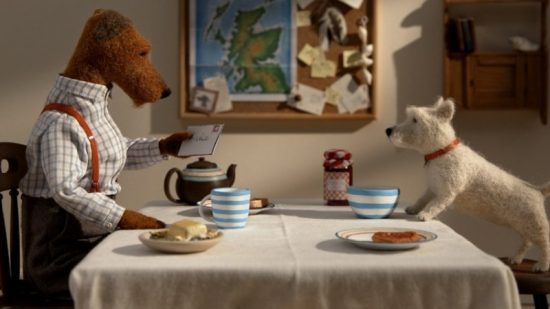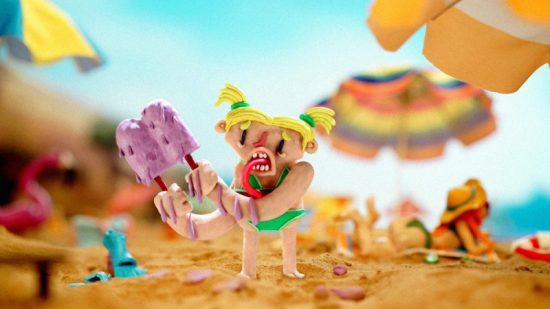EIFF 2019 – McLaren Animation Reviews
The annual McLaren Animation award screenings at the world’s oldest continually-running film festival have always been a personal favourite part of the festival for me. Named for famed Scottish pioneer Norman McLaren, who would later found the National Film Board of Canada, this 2019 edition was particularly special – this marked the thirtieth anniversary of the McLarens at the EIFF, and the tenth, and as it happens, final year in the tenure of Iain Gardner, who has been in charge of the McLarens. I’ve really enjoyed Iain’s run taking care of the McLarens – it isn’t just the selecting and screening of interesting and diverse material, it’s the sense of encouraging and supporting and fostering new and emerging and existing talent. During the post-screening Q&As with all of the animators, there is a real sense of support and encouragement, and that’s a good thing in any artistic medium if you want to have new blood and new ideas.
This year as part of the thirtieth anniversary we were treated to three rather than the usual two McLaren Animation segments, each with ten films, so thirty short works in all, covering all sorts of subjects (autobiography, documentary, politic, humour) and approaches (traditional hand-drawn, CG animation, stop-motion, puppetry and some films mixing methods). In a very welcome touch this year there was parity, a fifty-fifty split between female and male directors. At normal McLaren years, there are too many films for me to go into each one individually, and that is more the case this year with the additional screening, so I’ll be sticking to my usual approach of picking out some of the films which I personally enjoyed the most.
Ainslie Henderson – by now a well-kent face in animation circles and at McLaren – had a very beautiful, very emotional piece with Archie. A lovely stop-motion work, we follow an anthropomorphised dog-man (with his own actual pet dog!), the eponymous Archie, in a largely wordless film. Archie receives bad news and a key in the post – the key to this mother’s wee crofting house on one of the Scottish isles; she’s passed away, the old home is now his. Using only the movement of the figures rather than dialogue Henderson deftly conjures up that sudden, shattering blow of learning a loved one is gone, of the bottom falling out of your world, the sad journey back home to a house that is now empty, except not really, because it is filled with memories. It’s warm and sadly beautiful, with some nice little touches – Archie’s wee dog snuggling up to his master, sensing his pain – and I found myself thinking on loved ones I’ve lost and having to blink away years (I’m sure I wasn’t the only one).
Chris and Victoria Watson’s Ladder to You also dealt with grief, in a very different way, with an elderly man, at home, now all alone and missing his wife terribly. He ponders parts of his life and the world, but nothing really works any more, not without her; without her it is meaningless, empty. When his wife’s photograph is blown out the window he follows it with a ladder to try and retrieve this last memento of her, and it takes him somewhere special. Josephine Lohoar Self’s also had that beautifully sad quality to it, a stop-motion piece about a shy young tailor, about a world where everyone wants to conform and be the same while he yearns for difference and encounters love.
Music & Clowns – trailer from Alex Widdowson on Vimeo.
JoAnne Salmon and Alex Widdowson both impressed me with their biographical films, which were very emotionally warm and honest. Widdowson brought us Music & Clowns, an exploration of caring for a family member with Down’s Syndrome. The parents talk honestly about the shock and surprise when their boy was born “different”, with his father commenting how as he held his newborn the moment of shock passed and he knew that he loved his boy anyway; he even, as they discuss him, reproaches his other son gently, commenting on how he may not understand everything but he is very empathic to the feelings of others, perhaps more than his brother. They talk about what life has been like, and the concerns of his parents as they get older, wondering how he will cope once they are too old, or passed on, a concern anyone with special needs family members must entertain.
Salmon gave us Chin Up, an autobiographical piece, the title riffing on one of the symptoms of Treacher Collins syndrome, where the bone structure of the face doesn’t form in the regular way, giving her a very unusual appearance (including not having a prominent chin). Again emotional honesty was key here as Salmon used differing artistic style to explore moments of her life – her birth, not being the “normal” little girl they were expecting, of not feeling particularly different until she went to school and having to deal with the unthinking comments of children, of how this affected her sense of self, how art and drawing became an escape for her, which eventually lead her to find animation and encouraged her to apply to study and then eventually create her own works.
Chin Up – Trailer – Animated Documentary from LoveLove Films on Vimeo.
Lauren Orme’s Creepy Pasta Salad was a fun piece, about a werewolf lady with low self-esteem, a man who may (or at least thinks he may be) dead and a ghost (and wondering if he is a ghost does he have to worry about that final electricity bill?), a Goth and the End of the World, and left me with a big smile. Ainslie Henderson, with Will Anderson, had more work in the form of three very brief pieces, My Best Friend (then each segment had a subtitle, such as “explodes”), nice, clean, simple graphics, two friends talking, but they are aware of being in a film, and they ponder the meaning of each title as it appears above them (you can imagine their alarm when it says “explodes”). Matthew Lee’s One Liner used claymation and drawn animation and touches on what used to be a cornerstone of British entertainment culture – the comedy double act, and more specifically who was “the funny one” (that oft-asked question that totally misses the point that these duos really only worked playing off one another).
Unsurprisingly given the last couple of years, politics hove into view during some of the films: Steve Boot had Mad Dogs, set in a pub of the same name, the classic British pub, a perfect place for examining what it means to be British in the modern era, using a collection of regulars in the pub who are all dogs, English, Scottish and Welsh (although oddly no Northern Irish), and uses a sprinkling of dialogue from the speeches of famous people among the lines as they all talk about about their sense of identity. Marta Lemos gave us Dear England, which used photo collage and drawn art among other styles, to explore the way British society has been changing, especially since the Brexit referendum, the way some elements now feel they can voice bigotry and hatred openly, the fact that some who came to make a home here, no matter how they fit in, will never be “British enough” for certain types.
mad dog trailer from steve boot on Vimeo.
I’d love to pick out more of the entries – the styles, the methods and the subjects were all so diverse we really were treated to a smorgasbord of excellent animation talent, quite a few entries being graduate degree films from students, and many of those now out in the world beyond college all still very young. I must mention Fokion Xenos who won the audience vote to scoop this thirtieth anniversary year McLaren Animation Award with Heatwave, which was a wonderful riot of colours and life in plasticine and other materials and depicted, yes a heatwave, on a tiny Greek island, rather timely given the burst of hot weather across the UK and Europe recently! And I have to give a shout out to Samantha Moore’s Bloomers, which documented the people, mostly women, who had worked in a garment design and manufacturing, and the changing fortunes over the years – the film had a very rich texture to the backgrounds, and, astonishingly Moore produced a sheet of silk (one of the fabrics the factory used) on which some of the art had been drawn then animated to give it that remarkable look and feel.
HEATWAVE – Trailer © NFTS 2019 from Fokion Xenos on Vimeo.
As I said, a real diversity of styles, methods and subjects. I’m confident that – as usually happens – we will see some of the McLaren entries crop up in a few months in the BAFTA and Oscar short animation nominee lists.











